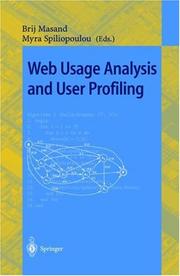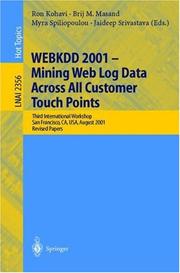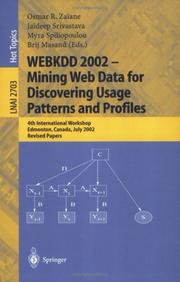| Listing 1 - 9 of 9 |
Sort by
|

ISBN: 3540449345 3540678182 Year: 2000 Publisher: Berlin, Heidelberg : Springer Berlin Heidelberg : Imprint: Springer,
Abstract | Keywords | Export | Availability | Bookmark
 Loading...
Loading...Choose an application
- Reference Manager
- EndNote
- RefWorks (Direct export to RefWorks)
After the advent of data mining and its successful application on conventional data, Web-related information has been an appropriate and increasingly popular target of knowledge discovery. Depending on whether the data used in the knowledge discovery process concerns the Web itself in terms of content or the usage of the content, one distinguishes between Web content mining and Web usage mining. This book is the first one entirely devoted to Web usage mining. It originates from the WEBKDD'99 Workshop held during the 1999 KDD Conference. The ten revised full papers presented together with an introductory survey by the volume editors documents the state of the art in this exciting new area. The book presents topical sections on Modeling the User, Discovering Rules and Patterns of Navigation, and Measuring interestingness in Web Usage Mining.
Web usage mining --- Internet users --- Library & Information Science --- Computer Science --- Engineering & Applied Sciences --- Social Sciences --- Web usage mining. --- Internet users. --- Web users --- World Wide Web users --- Analysis, Web usage --- Analytics, Web --- Mining, Web usage --- Web analytics --- Web usage analysis --- Computer science. --- Data structures (Computer science). --- User interfaces (Computer systems). --- Artificial intelligence. --- Computers and civilization. --- Computer Science. --- Data Structures, Cryptology and Information Theory. --- Artificial Intelligence (incl. Robotics). --- Popular Computer Science. --- Information Systems Applications (incl. Internet). --- User Interfaces and Human Computer Interaction. --- Computers and Society. --- Civilization and computers --- Civilization --- AI (Artificial intelligence) --- Artificial thinking --- Electronic brains --- Intellectronics --- Intelligence, Artificial --- Intelligent machines --- Machine intelligence --- Thinking, Artificial --- Bionics --- Cognitive science --- Digital computer simulation --- Electronic data processing --- Logic machines --- Machine theory --- Self-organizing systems --- Simulation methods --- Fifth generation computers --- Neural computers --- Interfaces, User (Computer systems) --- Human-machine systems --- Human-computer interaction --- Information structures (Computer science) --- Structures, Data (Computer science) --- Structures, Information (Computer science) --- File organization (Computer science) --- Abstract data types (Computer science) --- Informatics --- Science --- Computer users --- Personal Internet use in the workplace --- Data mining --- Data structures (Computer scienc. --- Data Structures and Information Theory. --- Artificial Intelligence. --- Application software. --- Application computer programs --- Application computer software --- Applications software --- Apps (Computer software) --- Computer software
Digital
ISBN: 9783540471288 Year: 2006 Publisher: Berlin Heidelberg Springer-Verlag GmbH
Abstract | Keywords | Export | Availability | Bookmark
 Loading...
Loading...Choose an application
- Reference Manager
- EndNote
- RefWorks (Direct export to RefWorks)
Computer architecture. Operating systems --- Information systems --- Artificial intelligence. Robotics. Simulation. Graphics --- Computer. Automation --- ICT (informatie- en communicatietechnieken) --- IR (information retrieval) --- informatica --- maatschappij --- informatiesystemen --- database management --- computernetwerken --- robots
Digital
ISBN: 9783540774853 Year: 2007 Publisher: Berlin, Heidelberg Springer-Verlag Berlin Heidelberg
Abstract | Keywords | Export | Availability | Bookmark
 Loading...
Loading...Choose an application
- Reference Manager
- EndNote
- RefWorks (Direct export to RefWorks)
Computer architecture. Operating systems --- Information systems --- Artificial intelligence. Robotics. Simulation. Graphics --- Computer. Automation --- ICT (informatie- en communicatietechnieken) --- IR (information retrieval) --- informatica --- maatschappij --- informatiesystemen --- database management --- KI (kunstmatige intelligentie) --- computernetwerken --- robots --- AI (artificiële intelligentie)

ISBN: 3540456406 3540439692 Year: 2002 Volume: 2356 Publisher: Berlin, Heidelberg : Springer Berlin Heidelberg : Imprint: Springer,
Abstract | Keywords | Export | Availability | Bookmark
 Loading...
Loading...Choose an application
- Reference Manager
- EndNote
- RefWorks (Direct export to RefWorks)
WorkshopTheme The ease and speed with which business transactions can be carried out over the Web has been a key driving force in the rapid growth of electronic commerce. In addition, customer interactions, including personalized content, e-mail c- paigns, and online feedback provide new channels of communication that were not previously available or were very ine?cient. The Web presents a key driving force in the rapid growth of electronic c- merceandanewchannelforcontentproviders.Knowledgeaboutthecustomeris fundamental for the establishment of viable e-commerce solutions. Rich web logs provide companies with data about their customers and prospective customers, allowing micro-segmentation and personalized interactions. Customer acqui- tion costs in the hundreds of dollars per customer are common, justifying heavy emphasis on correct targeting. Once customers are acquired, customer retention becomes the target. Retention through customer satisfaction and loyalty can be greatly improved by acquiring and exploiting knowledge about these customers and their needs. Althoughweblogsarethesourceforvaluableknowledgepatterns,oneshould keep in mind that the Web is only one of the interaction channels between a company and its customers. Data obtained from conventional channels provide invaluable knowledge on existing market segments, while mobile communication adds further customer groups. In response, companies are beginning to integrate multiple sources of data including web, wireless, call centers, and brick-a- mortar store data into a single data warehouse that provides a multifaceted view of their customers, their preferences, interests, and expectations.
Web usage mining --- Internet users --- Electronic commerce --- Library & Information Science --- Social Sciences --- Web users --- World Wide Web users --- Analysis, Web usage --- Analytics, Web --- Mining, Web usage --- Web analytics --- Web usage analysis --- Popular works. --- Data structures (Computer science). --- Database management. --- Information storage and retrieval. --- Artificial intelligence. --- Computer simulation. --- Computer science. --- Popular Science. --- Popular Computer Science. --- Data Structures, Cryptology and Information Theory. --- Simulation and Modeling. --- Artificial Intelligence (incl. Robotics). --- Database Management. --- Information Storage and Retrieval. --- Informatics --- Science --- Computer modeling --- Computer models --- Modeling, Computer --- Models, Computer --- Simulation, Computer --- Electromechanical analogies --- Mathematical models --- Simulation methods --- Model-integrated computing --- AI (Artificial intelligence) --- Artificial thinking --- Electronic brains --- Intellectronics --- Intelligence, Artificial --- Intelligent machines --- Machine intelligence --- Thinking, Artificial --- Bionics --- Cognitive science --- Digital computer simulation --- Electronic data processing --- Logic machines --- Machine theory --- Self-organizing systems --- Fifth generation computers --- Neural computers --- Data base management --- Data services (Database management) --- Database management services --- DBMS (Computer science) --- Generalized data management systems --- Services, Database management --- Systems, Database management --- Systems, Generalized database management --- Information structures (Computer science) --- Structures, Data (Computer science) --- Structures, Information (Computer science) --- File organization (Computer science) --- Abstract data types (Computer science) --- Computer users --- Personal Internet use in the workplace --- Data mining --- Data structures (Computer scienc. --- Information storage and retrieva. --- Data Structures and Information Theory. --- Artificial Intelligence. --- Information storage and retrieval systems. --- Automatic data storage --- Automatic information retrieval --- Automation in documentation --- Computer-based information systems --- Data processing systems --- Data storage and retrieval systems --- Discovery systems, Information --- Information discovery systems --- Information processing systems --- Information retrieval systems --- Machine data storage and retrieval --- Mechanized information storage and retrieval systems --- Computer systems --- Electronic information resources --- Data libraries --- Digital libraries --- Information organization --- Information retrieval

ISBN: 3540396632 3540203044 Year: 2003 Publisher: Berlin, Heidelberg : Springer Berlin Heidelberg : Imprint: Springer,
Abstract | Keywords | Export | Availability | Bookmark
 Loading...
Loading...Choose an application
- Reference Manager
- EndNote
- RefWorks (Direct export to RefWorks)
1 WorkshopTheme Data mining as a discipline aims to relate the analysis of large amounts of user data to shed light on key business questions. Web usage mining in particular, a relatively young discipline, investigates methodologies and techniques that - dress the unique challenges of discovering insights from Web usage data, aiming toevaluateWebusability,understandtheinterestsandexpectationsofusersand assess the e?ectiveness of content delivery. The maturing and expanding Web presents a key driving force in the rapid growth of electronic commerce and a new channel for content providers. Customized o?ers and content, made possible by discovered knowledge about the customer, are fundamental for the establi- ment of viable e-commerce solutions and sustained and e?ective content delivery in noncommercial domains. Rich Web logs provide companies with data about their online visitors and prospective customers, allowing microsegmentation and personalized interactions. While Web mining as a domain is several years old, the challenges that characterize data analysis in this area continue to be formidable. Though p- processing data routinely takes up a major part of the e?ort in data mining, Web usage data presents further challenges based on the di?culties of assigning data streams to unique users and tracking them over time. New innovations are required to reliably reconstruct sessions, to ascertain similarity and di?erences between sessions, and to be able to segment online users into relevant groups.
Web usage mining --- Internet users --- Library & Information Science --- Social Sciences --- Web users --- World Wide Web users --- Analysis, Web usage --- Analytics, Web --- Mining, Web usage --- Web analytics --- Web usage analysis --- Popular works. --- Computer communication systems. --- Database management. --- Information storage and retrieval. --- Artificial intelligence. --- Computer science. --- Popular Science. --- Popular Computer Science. --- Artificial Intelligence (incl. Robotics). --- Computer Communication Networks. --- Database Management. --- Information Storage and Retrieval. --- Information Systems Applications (incl. Internet). --- Informatics --- Science --- AI (Artificial intelligence) --- Artificial thinking --- Electronic brains --- Intellectronics --- Intelligence, Artificial --- Intelligent machines --- Machine intelligence --- Thinking, Artificial --- Bionics --- Cognitive science --- Digital computer simulation --- Electronic data processing --- Logic machines --- Machine theory --- Self-organizing systems --- Simulation methods --- Fifth generation computers --- Neural computers --- Data base management --- Data services (Database management) --- Database management services --- DBMS (Computer science) --- Generalized data management systems --- Services, Database management --- Systems, Database management --- Systems, Generalized database management --- Communication systems, Computer --- Computer communication systems --- Data networks, Computer --- ECNs (Electronic communication networks) --- Electronic communication networks --- Networks, Computer --- Teleprocessing networks --- Data transmission systems --- Digital communications --- Electronic systems --- Information networks --- Telecommunication --- Cyberinfrastructure --- Network computers --- Distributed processing --- Computer users --- Personal Internet use in the workplace --- Data mining --- Information storage and retrieva. --- Artificial Intelligence. --- Information storage and retrieval systems. --- Automatic data storage --- Automatic information retrieval --- Automation in documentation --- Computer-based information systems --- Data processing systems --- Data storage and retrieval systems --- Discovery systems, Information --- Information discovery systems --- Information processing systems --- Information retrieval systems --- Machine data storage and retrieval --- Mechanized information storage and retrieval systems --- Computer systems --- Electronic information resources --- Data libraries --- Digital libraries --- Information organization --- Information retrieval --- Application software. --- Application computer programs --- Application computer software --- Applications software --- Apps (Computer software) --- Computer software
Book

ISBN: 9783540774853 Year: 2007 Publisher: Berlin, Heidelberg Springer-Verlag Berlin Heidelberg
Abstract | Keywords | Export | Availability | Bookmark
 Loading...
Loading...Choose an application
- Reference Manager
- EndNote
- RefWorks (Direct export to RefWorks)
This book contains the postworkshop proceedings with selected revised papers from the 8th international workshop on knowledge discovery from the Web, WEBKDD 2006. The WEBKDD workshop series has taken place as part of the ACM SIGKDD International Conference on Knowledge Discovery and Data Mining (KDD) since 1999. The discipline of data mining delivers methodologies and tools for the an- ysis of large data volumes and the extraction of comprehensible and non-trivial insights from them. Web mining, a much younger discipline, concentrates on the analysisofdata pertinentto the Web.Web mining methods areappliedonusage data and Web site content; they strive to improve our understanding of how the Web is used, to enhance usability and to promote mutual satisfaction between e-business venues and their potential customers. Inthelastfewyears,theinterestfortheWebasamediumforcommunication, interaction and business has led to new challenges and to intensive, dedicated research.Many ofthe infancy problems in Web mining have been solvedby now, but the tremendous potential for new and improved uses, as well as misuses, of the Web are leading to new challenges. ThethemeoftheWebKDD2006workshopwasKnowledgeDiscoveryonthe Web , encompassing lessons learned over the past few years and new challenges for the years to come. While some of the infancy problems of Web analysis have beensolvedandproposedmethodologieshavereachedmaturity,therealityposes newchallenges:TheWebisevolvingconstantly;siteschangeanduserpreferences drift. And, most of all, a Web site is more than a see-and-click medium; it is a venue where a user interacts with a site owner or with other users, where group behavior is exhibited, communities are formed and experiences are shared.
Computer architecture. Operating systems --- Information systems --- Artificial intelligence. Robotics. Simulation. Graphics --- Computer. Automation --- ICT (informatie- en communicatietechnieken) --- IR (information retrieval) --- informatica --- maatschappij --- informatiesystemen --- database management --- KI (kunstmatige intelligentie) --- computernetwerken --- robots
Book
ISBN: 9783540471288 Year: 2006 Publisher: Berlin Heidelberg Springer-Verlag GmbH.
Abstract | Keywords | Export | Availability | Bookmark
 Loading...
Loading...Choose an application
- Reference Manager
- EndNote
- RefWorks (Direct export to RefWorks)
TheWebisaliveenvironmentthatmanagesanddrivesawidespectrumofapp- cations in which a user may interact with a company, a governmental authority, a non-governmental organization or other non-pro?t institution or other users. User preferences and expectations, together with usage patterns, form the basis for personalized, user-friendly and business-optimal services. Key Web business metrics enabled by proper data capture and processing are essential to run an e?ective business or service. Enabling technologies include data mining, sc- able warehousing and preprocessing, sequence discovery, real time processing, document classi?cation, user modeling and quality evaluation models for them. Recipient technologies required for user pro?ling and usage patterns include recommendation systems, Web analytics applications, and application servers, coupled with content management systems and fraud detectors. Furthermore, the inherent and increasing heterogeneity of the Web has - quired Web-based applications to more e?ectively integrate a variety of types of data across multiple channels and from di?erent sources. The development and application of Web mining techniques in the context of Web content, Web usage, and Web structure data has already resulted in dramatic improvements in a variety of Web applications, from search engines, Web agents, and content management systems, to Web analytics and personalization services. A focus on techniques and architectures for more e?ective integration and mining of c- tent, usage,and structure data from di?erent sourcesis likely to leadto the next generation of more useful and more intelligent applications.
Computer architecture. Operating systems --- Information systems --- Artificial intelligence. Robotics. Simulation. Graphics --- Computer. Automation --- ICT (informatie- en communicatietechnieken) --- IR (information retrieval) --- informatica --- maatschappij --- informatiesystemen --- database management --- computernetwerken --- robots
Book

ISBN: 9783540463481 Year: 2006 Publisher: Berlin Heidelberg Springer-Verlag GmbH.
Abstract | Keywords | Export | Availability | Bookmark
 Loading...
Loading...Choose an application
- Reference Manager
- EndNote
- RefWorks (Direct export to RefWorks)
Thisbookcontainsthepostworkshopproceedingsofthe7thInternationalWo- shop on Knowledge Discovery from the Web, WEBKDD 2005. The WEBKDD workshop series takes place as part of the ACM SIGKDD International Conf- ence on Knowledge Discovery and Data Mining (KDD) since 1999. The discipline of data mining delivers methodologies and tools for the an- ysis of large data volumes and the extraction of comprehensible and non-trivial insights from them. Web mining, a much younger discipline, concentrates on the analysisofdata pertinentto theWeb.Web mining methods areappliedonusage data and Web site content; they strive to improve our understanding of how the Web is used, to enhance usability and to promote mutual satisfaction between e-business venues and their potential customers. In the last years, the interest for the Web as medium for communication, interaction and business has led to new challenges and to intensive, dedicated research. Many of the infancy problems in Web mining have now been solved but the tremendous potential for new and improved uses, as well as misuses, of the Web are leading to new challenges.
Computer architecture. Operating systems --- Information systems --- Artificial intelligence. Robotics. Simulation. Graphics --- Computer. Automation --- ICT (informatie- en communicatietechnieken) --- IR (information retrieval) --- informatica --- maatschappij --- informatiesystemen --- database management --- KI (kunstmatige intelligentie) --- computernetwerken --- robots
Digital

ISBN: 9783540463481 Year: 2006 Publisher: Berlin Heidelberg Springer-Verlag GmbH
Abstract | Keywords | Export | Availability | Bookmark
 Loading...
Loading...Choose an application
- Reference Manager
- EndNote
- RefWorks (Direct export to RefWorks)
Computer architecture. Operating systems --- Information systems --- Artificial intelligence. Robotics. Simulation. Graphics --- Computer. Automation --- ICT (informatie- en communicatietechnieken) --- IR (information retrieval) --- informatica --- maatschappij --- informatiesystemen --- database management --- KI (kunstmatige intelligentie) --- computernetwerken --- robots --- AI (artificiële intelligentie)
| Listing 1 - 9 of 9 |
Sort by
|

 Search
Search Feedback
Feedback About UniCat
About UniCat  Help
Help News
News